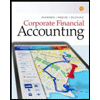
Concept explainers
1.
Cash dividends: The amount of cash provided by a corporation out of its distributable profits to its shareholders as a return for the amount invested by them is referred as cash dividends.
Common stock: These are the ordinary shares that a corporation issues to the investors in order to raise funds. In return, the investors receive a share of profit from the profits earned by the corporation. The dividend payments are not guaranteed and are paid after the payment made to the preferred stockholders.
Preferred stock: The stock that provides a fixed amount of return (dividend) to its stockholder before paying dividends to common stockholders is referred as preferred stock.
A preferred stock may be cumulative and non-cumulative. A cumulative preferred stock implies that a preferred stockholder is entitled to receive dividends for the current year plus any unpaid dividends of the previous years, before the dividends paid to the common stockholders.
Dividend per share:
Dividend per share represents the amount of dividend paid to each shareholders of the business.
To determine: The total dividends and the amount of dividends declared per share for preferred and common stock for each of the six years.
2.
The average annual dividend per share for each class of stock for the six-year period.
3.
The average annual percentage return on initial stockholders’ investment, based on the average annual dividend per share for (A) preferred stock and (B) common stock.
Trending nowThis is a popular solution!

Chapter 13 Solutions
Bundle: Accounting, 27th Edition, Loose-leaf Version + Cengagenowv2, 1 Term Printed Access
- Atwater Chemicals produces an engine additive for machinery. The additive is produced by adding various ingredients to a petroleum-based lubricant. Atwater purchases the lubricant from two suppliers, Woodlawn Petroleum and Spokane Chemicals. The quality of the final product depends directly on the quality of the lubricant. If the lubricant is "off," Atwater has to dispose of the entire batch. Because all lubricant can be "off," Atwater uses a measure it calls the “yield,” which is computed as Yield = Good output ÷ Input where the output and input are both measured in barrels. As a benchmark, Atwater expects to get 12 barrels of good output for every 16 barrels of lubricant purchased for a yield of 75 percent (= 12 barrels of output ÷ 16 barrels of lubricant). Data on the two suppliers for the past year follow: Woodlawn Petroleum Spokane Chemicals Total Total inputs purchased (barrels) 5,760 3,600 9,360 Good output (barrels) 3,744 3,096 6,840 Average price (per barrel) $ 121.00 $…arrow_forwardI am searching for the correct answer to this general accounting problem with proper accounting rules.arrow_forwardWatko Entertainment Systems (WES) buys audio and video components for assembling home entertainment systems from two suppliers, Bacon Electronics and Hessel Audio and Video. The components are delivered in cartons. If the cartons are delivered late, the installation for the customer is delayed. Delayed installations lead to contractual penalties that call for WES to reimburse a portion of the purchase price to the customer. During the past quarter, the purchasing and delivery data for the two suppliers showed the following: Bacon Hessel Total Total purchases (cartons) 5,000 3,000 8,000 Average purchase price (per carton) $ 168 $ 184 $ 174 Number of deliveries 40 20 60 Percentage of cartons delivered late. 30% 15% 25% The Accounting Department recorded $241,800 as the cost of late deliveries to customers. Required: Assume that the average quality, measured by the percentage of late deliveries, and prices from the two companies will continue as in the past. Also…arrow_forward
- Please help me solve this financial accounting problem with the correct financial process.arrow_forwardPlease provide the accurate answer to this general accounting problem using appropriate methods.arrow_forwardI need help finding the accurate solution to this general accounting problem with valid methods.arrow_forward
- Principles of Accounting Volume 1AccountingISBN:9781947172685Author:OpenStaxPublisher:OpenStax College
 College Accounting, Chapters 1-27AccountingISBN:9781337794756Author:HEINTZ, James A.Publisher:Cengage Learning,
College Accounting, Chapters 1-27AccountingISBN:9781337794756Author:HEINTZ, James A.Publisher:Cengage Learning, Corporate Financial AccountingAccountingISBN:9781305653535Author:Carl Warren, James M. Reeve, Jonathan DuchacPublisher:Cengage Learning
Corporate Financial AccountingAccountingISBN:9781305653535Author:Carl Warren, James M. Reeve, Jonathan DuchacPublisher:Cengage Learning  Managerial Accounting: The Cornerstone of Busines...AccountingISBN:9781337115773Author:Maryanne M. Mowen, Don R. Hansen, Dan L. HeitgerPublisher:Cengage Learning
Managerial Accounting: The Cornerstone of Busines...AccountingISBN:9781337115773Author:Maryanne M. Mowen, Don R. Hansen, Dan L. HeitgerPublisher:Cengage Learning Intermediate Accounting: Reporting And AnalysisAccountingISBN:9781337788281Author:James M. Wahlen, Jefferson P. Jones, Donald PagachPublisher:Cengage Learning
Intermediate Accounting: Reporting And AnalysisAccountingISBN:9781337788281Author:James M. Wahlen, Jefferson P. Jones, Donald PagachPublisher:Cengage Learning





